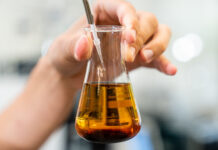by Rita Lorenzini
Various substances extracted from algae (seaweeds), are contained in many foods produced by the food industry. These substances have been used for a very long time in food technologies, so that some texturizers like carrageenan and alginate have been present for decades on the market. A certain advantage of the ingredients obtained from algae is to be considered as “sustainable” due to the remarkable quantity of algae present in nature and their easy and fast growth. Since algae (seaweeds) grow in a marine environment and do not have a strong supporting structure, they contain some substances able to effectively keep water and give them turgor. These substances are ideal for a number of food applications such as forming gels, incorporate water, give consistence, thicken, stabilize suspensions, etc. The food sectors where they are used are numerous, not only the dairy and confectionery ones (in particular for puddings, creams and ice-creams), but also for the preparation of meat, fish, sauces and flavoring and even for pasta and bakery (1). Among the main algae (seaweed) additives which have been used for a long time, there are the below listed ones.
 Carrageenan. In actual fact it is a group of substances made of long polysaccharide chains, with a molecular weight from 200 to 800 kDa (kilo Dalton), obtained from some varieties of red algae (seaweeds) typical of tropical seas. The various carrageenan, even if are all included under the label E407, have a chemical structure which is slightly different and are characterized by different gelling properties. There are the iota- carrageenan (from the Kappaphycus Alvarezii algae), the kappa- carrageenan (from the Eucheuma denticulatum) and the lambda- carrageenan (mainly from the Gigartina pistillata or Chrondrus crispo algae). Carrageenan has been used for over 70 years as a food additive, particularly for modifying the texture, as a thickener and gelling element. It is considered as safe under a toxicological point of view, but recently a scientific research (2) has risen some doubts about it. It seems that the substance, or better some fragments with a low molecular weight deriving from it (formed during the production process or during the intestinal digestion or the microbial degradation), has an inflammatory effect on the intestinal cells. Instead the carrageenan, because of the very big dimensions of its molecule, does not seem to have great capacities to penetrate into the intestinal epithelium. According to another very recent research (3), carrageenan would even have negative effects connected to the outbreak of diabetes such increase of glucose intolerance and resistance to insulin. The producing companies do not consider these studies as reliable and they think that the substance has been used without any problems for a long time; however, it has to be taken into consideration that the levels of assumption for each person have significantly increased during the years, and (in the USA) they have arrived to about 80 mg of this additive per day. As regards the European Union, in 2003 the safe use of the substance was confirmed, but a limit of 5% of low molecular weight carrageenan (50 kDa) in transformed foods, was imposed.
Carrageenan. In actual fact it is a group of substances made of long polysaccharide chains, with a molecular weight from 200 to 800 kDa (kilo Dalton), obtained from some varieties of red algae (seaweeds) typical of tropical seas. The various carrageenan, even if are all included under the label E407, have a chemical structure which is slightly different and are characterized by different gelling properties. There are the iota- carrageenan (from the Kappaphycus Alvarezii algae), the kappa- carrageenan (from the Eucheuma denticulatum) and the lambda- carrageenan (mainly from the Gigartina pistillata or Chrondrus crispo algae). Carrageenan has been used for over 70 years as a food additive, particularly for modifying the texture, as a thickener and gelling element. It is considered as safe under a toxicological point of view, but recently a scientific research (2) has risen some doubts about it. It seems that the substance, or better some fragments with a low molecular weight deriving from it (formed during the production process or during the intestinal digestion or the microbial degradation), has an inflammatory effect on the intestinal cells. Instead the carrageenan, because of the very big dimensions of its molecule, does not seem to have great capacities to penetrate into the intestinal epithelium. According to another very recent research (3), carrageenan would even have negative effects connected to the outbreak of diabetes such increase of glucose intolerance and resistance to insulin. The producing companies do not consider these studies as reliable and they think that the substance has been used without any problems for a long time; however, it has to be taken into consideration that the levels of assumption for each person have significantly increased during the years, and (in the USA) they have arrived to about 80 mg of this additive per day. As regards the European Union, in 2003 the safe use of the substance was confirmed, but a limit of 5% of low molecular weight carrageenan (50 kDa) in transformed foods, was imposed.
Alginate. The alginic acid is an anionic polysaccharide which is highly present in the cell walls of brown algae such as Macrocystis pyrifera, Ascophyllum nodosum and various kinds of Laminaria. It quickly gives origin to a viscous gel, able to absorb water in a proportion of 200-300 times its weight. Its applications are numerous and go beyond the use as a thickener: films for food packaging made of alginate, have been developed recently (4). It is often used in its salified forms: sodium, potassium or calcium alginate (the one that gives origin to the more stable and consistent ones).




